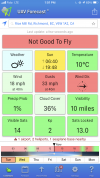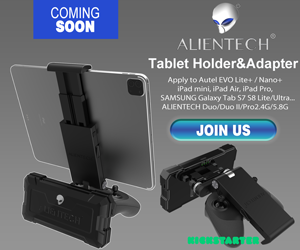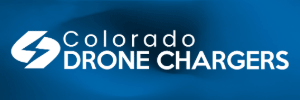- Joined
- Jul 5, 2022
- Messages
- 86
- Reaction score
- 60
- Age
- 62
Autel EVO Nano +
Post editing suites used:
PhotoNinja (RAW correction - output to 32 bit floating point TIF)
Darktable (primary TIF correction & editing - output to lossless 8 bit JPG)
Sensor aberrations.
* Editing software recognises red/magenta hues as chromatic aberrations
* RAW 'images' badly over-saturated with a green/yellow bias
* Blue (sky blue in particular) presents as metallic and unnatural
* Yellow cast toned-down but still exists in RAW
* Very noticeable lateral drop-off in the outer horizontal thirds of frame - similar to vignetting but with a foggy greyish-blue cast.
Lens distortion characteristics.
Not appreciably bad. Relatively minor pincushion/moustache distortion in RAW. Surprising given that this is a wide-angle lens. Quite impressed by the lens assembly. Autel needs to release the camera firmware LCP to Adobe & Lensfun databases ASAP.
The fact that geofencing is not present in Autel drones (at this time) is a major selling-point and since buying this unit as opposed to the DJI Mini 3 Pro, I can honestly say that I really like this wren of a drone but Autel needs to address the lens and sensor aberrations with urgency. This is not a cheap drone. A consumer can buy 2 DJI Mini 2's for the same price as 1 Nano + with the premium bundle - with the price as it stands: the Nano + camera needs to be THE stand-out reason why this product is priced at this level. The EVO Nano + has the potential to be a great professional level camera drone, but work needs to be done to improve the quality and consistency of the RAW images it captures.
The digital zoom function is a gimmick. At 2x zoom: it is tolerable. Anything past this and the image quality is unusable. The excuse that it is perfect for long-range scouting purposes is very reminiscent of DJI claiming the same for the frankly useless 12mp "hybrid zoom" unit tacked on to the top of the Mavic 3's Hasselblad camera. Autel needs to sacrifice the features that don't work well (and never will work well... digital zoom!) and shoehorn substitute code into the firmware that improves the quality, operation and output from the RYYB sensor.
The RYYB quad-Bayer sensor was a brave move, a radical side-step flying in the face of current norms, reminding me of Sigma's Foveon X3 sensor DSLR experiments (SD1: SD14: SD15 etc.) and it is clear that like the Foveon X3 Sigma cameras - the Nano + camera has the potential to be able to capture astonishing quality images. But Autel needs to act with haste and concentrate on first getting the Nano + camera right: and then perfecting it. By doing this, they will turn this little drone into the imaging sledgehammer that it COULD be and deliver a sledgehammer blow: knocking the DJI Mini 3 Pro straight off the top spot and keeping the DJI brand on the back foot for the forseeable future. Even now: the Nano + camera has demonstrably better low-light capabilities than the DJI Mini 2: Mini 3 Pro and Air 2S, as proven by numerous night-shoot comparisons uploaded to Youtube.
I want to see the drone I am so impressed with already polished and perfected. Autel Robotics have the perfect opportunity to set a much higher benchmark than DJI in the sub-250 gram category - I hope they don't waste the opportunity.
Post editing suites used:
PhotoNinja (RAW correction - output to 32 bit floating point TIF)
Darktable (primary TIF correction & editing - output to lossless 8 bit JPG)
Sensor aberrations.
* Editing software recognises red/magenta hues as chromatic aberrations
* RAW 'images' badly over-saturated with a green/yellow bias
* Blue (sky blue in particular) presents as metallic and unnatural
* Yellow cast toned-down but still exists in RAW
* Very noticeable lateral drop-off in the outer horizontal thirds of frame - similar to vignetting but with a foggy greyish-blue cast.
Lens distortion characteristics.
Not appreciably bad. Relatively minor pincushion/moustache distortion in RAW. Surprising given that this is a wide-angle lens. Quite impressed by the lens assembly. Autel needs to release the camera firmware LCP to Adobe & Lensfun databases ASAP.
The fact that geofencing is not present in Autel drones (at this time) is a major selling-point and since buying this unit as opposed to the DJI Mini 3 Pro, I can honestly say that I really like this wren of a drone but Autel needs to address the lens and sensor aberrations with urgency. This is not a cheap drone. A consumer can buy 2 DJI Mini 2's for the same price as 1 Nano + with the premium bundle - with the price as it stands: the Nano + camera needs to be THE stand-out reason why this product is priced at this level. The EVO Nano + has the potential to be a great professional level camera drone, but work needs to be done to improve the quality and consistency of the RAW images it captures.
The digital zoom function is a gimmick. At 2x zoom: it is tolerable. Anything past this and the image quality is unusable. The excuse that it is perfect for long-range scouting purposes is very reminiscent of DJI claiming the same for the frankly useless 12mp "hybrid zoom" unit tacked on to the top of the Mavic 3's Hasselblad camera. Autel needs to sacrifice the features that don't work well (and never will work well... digital zoom!) and shoehorn substitute code into the firmware that improves the quality, operation and output from the RYYB sensor.
The RYYB quad-Bayer sensor was a brave move, a radical side-step flying in the face of current norms, reminding me of Sigma's Foveon X3 sensor DSLR experiments (SD1: SD14: SD15 etc.) and it is clear that like the Foveon X3 Sigma cameras - the Nano + camera has the potential to be able to capture astonishing quality images. But Autel needs to act with haste and concentrate on first getting the Nano + camera right: and then perfecting it. By doing this, they will turn this little drone into the imaging sledgehammer that it COULD be and deliver a sledgehammer blow: knocking the DJI Mini 3 Pro straight off the top spot and keeping the DJI brand on the back foot for the forseeable future. Even now: the Nano + camera has demonstrably better low-light capabilities than the DJI Mini 2: Mini 3 Pro and Air 2S, as proven by numerous night-shoot comparisons uploaded to Youtube.
I want to see the drone I am so impressed with already polished and perfected. Autel Robotics have the perfect opportunity to set a much higher benchmark than DJI in the sub-250 gram category - I hope they don't waste the opportunity.





